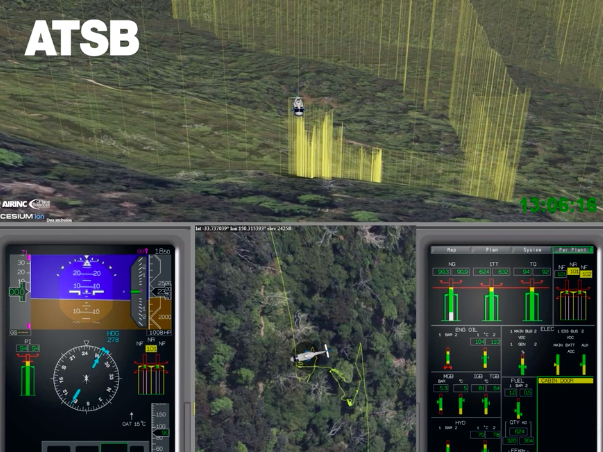Leonardo Helicopter AW139 Drifts, Over-Torques During Rescue

The Australian Transport Safety Bureau (ATSB) has welcomed a range of safety actions taken by an operator and the regulator after a serious incident involving a Leonardo rescue helicopter west of Sydney.
On the night of March 25, 2021, a Leonardo Helicopter AW139 was in an 85-foot hover during winching operations near Katoomba, New South Wales. On board were a pilot, an aircrew officer, a doctor, and a paramedic.
The pilot was maintaining the hover using visual reference points aided by night vision goggles and the aircraft’s landing lights.
Just as the paramedic was being winched down toward an injured bushwalker, the Leonardo aircraft began to drift and bank towards nearby cliffs.
In response, the pilot pitched the aircraft away from the cliffs, lifting the nose to a maximum pitch of 51 degrees. The paramedic held onto the flight step and was uninjured. A warning indicated the engine was being over-torqued during the maneuver.
The helicopter subsequently returned to Bankstown Airport without further incident. An engineering inspection did not reveal any fault or damage.
The ATSB’s systemic investigation into the Leonardo AW139 helicopter incident, which was classified as a loss of control and near collision with terrain, identified four safety issues among the factors which either contributed to, or increased risk in the occurrence.
“Pleasingly, the ATSB’s final report notes safety actions have been taken in response to all four of these issues,” Chief Commissioner Angus Mitchell said.
It was found the external white lighting on the aircraft did not provide sufficient illumination for the pilot to maintain adequate visual references, and relevant regulations at the time did not provide guidance or minimum requirements regarding the specifications or power output of the lights.
“While flying visually at night, it is crucial that pilots have sufficient visual reference to see and avoid obstacles,” Mr. Mitchell said.
“Visual cues are also required to maintain orientation so pilots know which way is up and can maintain control of their aircraft.”
Since the incident, the helicopter operator has fitted all contract aircraft with a high-intensity Trakka searchlight, ensuring adequate lighting is available.
Additionally, the Civil Aviation Safety Authority (CASA) has made substantive changes to the Night Vision Imaging Systems (NVIS) Multi-Part AC 91-13, including guidance on the type of searchlight fitted, and quantitative guidance regarding capability.
“Separately, the ATSB’s investigation found the operator provided insufficient guidance for the in-flight risk assessment specific to NVIS winch operations, which led to the crew not evaluating or discussing elements which made the winch site highly challenging,” Mr. Mitchell continued.
“In response, the operator has made significant and welcome changes to its winching procedures, including adding guidance on risk management, pre-mission and pre-winch risk assessment, and confirming and maintaining adequate visual references during winching operations.”
The operator has also addressed a finding regarding flight crew currency for NVIS winch operations, with the addition of a six-monthly recency requirement for NVIS winching in complex terrain, one of which is supervised by a Training and Checking pilot.
“CASA has also advised it will review the NVIS recency requirements, giving consideration to align them with instrument flight recency requirements,” Mr. Mitchell noted.
“But operators are reminded that regulations only set out minimum requirements, and they should assess the risks of their operations and modify procedures, manuals, and risk assessments accordingly.”
While the investigation’s final report details mostly positive outcomes, it also notes the audio recording from the helicopter’s solid-state multi-purpose flight recorder was not quarantined by the operator, reducing the information available for the investigation.
“Operators should remain aware that it is a requirement under the Transport Safety Investigation Act 2003 to quarantine evidence, including flight data recorders and cockpit voice recorders, when requested by the ATSB,” Mr. Mitchell said.
“This data and audio can often be some of the most useful and compelling evidence in an investigation, and can assist in finding safety factors, ultimately benefiting safety.”
Key points:
- ATSB has concluded a systemic investigation into the loss of control and near collision with terrain of a rescue helicopter in March 2021;
- Final report notes a series of safety actions taken by the aircraft operator and the Civil Aviation Safety Authority;
- All operators are reminded of their obligations to preserve flight data and cockpit voice recordings when requested by ATSB.
Read the final ATSB report: Loss of control and near collision with terrain involving Leonardo Helicopters AW139, VH-TJH, near Katoomba, New South Wales on 26 March 2021, publication date, 7/14/2023.



